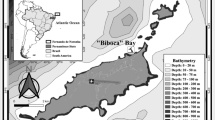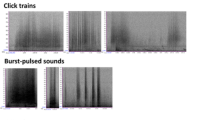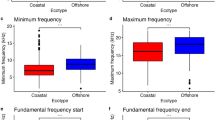Abstract
In many passerine species certain song structures have evolved to convey information to conspecific males or females. For example, in the common nightingale Luscinia megarhynchos, the ‘whistle part’ is a striking acoustic feature of some song types. Whistle songs have been suspected to be particularly well suited to attract females and/or to be important during female choice, but this has never been tested directly. In this study, we used a two-pronged approach for addressing the function of whistle songs in intersexual communication. First, we analysed relationships between whistle song features and male characteristics reflecting overall male quality. We found that the number of whistle songs produced and acoustic consistency of single whistle elements predicted male body measures, i.e., males who sang more whistle songs were heavier and larger, and produced whistle elements with higher consistency. Second, we conducted playback experiments with females either with or without whistle songs. Females responded more strongly to whistle songs by moving and vocalizing more during the whistle playback. We conclude that whistle songs might play an important role in nightingale mating, as they evoke high arousal in females, and different whistle song features may signal different aspects of male quality to females.
Zusammenfassung
Der Pfeifgesang der Nachtigall: korrelierte Männchenmerkmale und weibliche Gesangspräferenzen
Bei vielen Singvogelarten haben sich bestimmte Gesänge entwickelt, die an artgleiche Männchen oder Weibchen adressiert werden. So sind beispielsweise die sogenannten Pfeifstrophen ein sehr auffälliges Merkmal im Gesang der Nachtigall Luscinia megarhynchos. Obwohl dieser Pfeifgesang bereits seit Längerem im Verdacht steht eine besondere Bedeutung vor allem bei der Werbung der Weibchen zu haben, existierte hierfür bislang kein direkter Nachweis. In der vorliegenden Studie wurde diese für den Verpaarungskontext postulierte Funktion des Pfeifgesanges unter Anwendung zweier verschiedener Ansätze genauer untersucht. Zum einen wurde geprüft, inwieweit sich Beziehungen zwischen spezifischen Aspekten des Pfeifgesanges und anderen Männchenmerkmalen, die im Allgemeinen die Qualität eines Männchens anzeigen, nachweisen lassen. Hier ergaben die Analysen, dass die Häufigkeit der vorgetragenen Pfeifstrophen im nächtlichen Gesang der Nachtigall stark mit bestimmten Körperabmessungen männlicher Tiere korreliert. So sangen schwerere und größere Männchen in der Regel mehr Pfeifstrophen. Ein ähnlicher Zusammenhang ließ sich auch bezüglich einer erhöhten Kopiertreue beim Vortragen der einzelnen aufeinanderfolgenden Pfeifelemente nachweisen. Darüber hinaus wurde die Wirkung des Pfeifgesanges auf weibliche Nachtigallen untersucht. Hierzu wurden den Weibchen verschiedene Männchengesänge vorgespielt, die entweder einen hohen Anteil an Pfeifstrophen aufwiesen, oder aber gar keine Pfeifstrophen enthielten. Dabei reagierten die Weibchen eindeutig stärker auf die Gesänge mit hohem Pfeifstrophenanteil. Aufgrund dieser Befunde kommen wir zu der Schlussfolgerung, dass der Pfeifstrophengesang der Nachtigall in der Tat eine wichtige Rolle in Verpaarungskontexten übernimmt, da er zum einen stimulierend auf die Weibchen wirkt und zum anderen als Indikator für diverse Qualitätsaspekte der Männchen fungieren kann.







Similar content being viewed by others
References
Alatalo RV, Gustafsson L, Lundberg A (1990) Phenotypic selection and heritable size traits: environmental variance and genetic response. Am Nat 135:467–471
Amrhein V, Korner P, Naguib M (2002) Nocturnal and diurnal singing activity in the nightingale: correlations with mating status and breeding cycle. Anim Behav 64:939–944
Amy M, Salvin P, Naguib M, Leboucher G (2015) Female signalling to male song in the domestic canary, Serinus canaria. R Soc Open Sci 2:140196
Andersson MB (1994) Sexual selection. Princeton University Press, Princeton
Baker MC (1983) The behavioural response of female Nuttall’s white-crowned sparrows to male song of natal and alien dialects. Behav Ecol Sociobiol 12:309–315
Ballentine B, Hyman J, Nowicki S (2004) Vocal performance influences female response to male bird song: an experimental test. Behav Ecol 15:163–168
Ballintijn M, ten Cate C (1998) Sound production in the collared dove: a test of the whistle hypothesis. J Exp Biol 201:1637–1649
Bartsch C, Wenchel R, Kaiser A, Kipper S (2014) Singing onstage: female and male common nightingales eavesdrop on song type matching. Behav Ecol Sociobiol 68:1163–1171
Beecher MD, Brenowitz EA (2005) Functional aspects of song learning in songbirds. Trends Ecol Evol 20:143–149
Bartsch C, Weiss M, Kipper S (2015) Multiple song features are related to paternal effort in Common nightingales (accepted)
Beletsky LD (1983) Aggressive and pair-bond maintenance songs of female red-winged Blackbirds (Agelaius pboeniceus). Zeitschrift für Tierpsychologie 62:47–54
Bolsinger JS (2000) Use of two song categories by Golden-cheeked Warblers. Condor 102:539–552
Botero CA, Rossman RJ, Caro LM, Stenzler LM, Lovette IJ, de Kort SR, Vehrencamp SL (2009) Syllable type consistency is related to age, social status and reproductive success in the tropical mockingbird. Anim Behav 77:701–706
Brunner P, Pasinelli G (2010) Variation in singing style use in the reed bunting Emberiza schoeniclus: influencing factors and possible functions. J Avian Biol 41:388–397
Byers BE (1996) Messages encoded in the songs of chestnut-sided warblers. Anim Behav 52:691–705
Byers BE (2007) Extrapair paternity in chestnut-sided warblers is correlated with consistent vocal performance. Behav Ecol 18:130–136
Byers BE, Kroodsma DE (2009) Female mate choice and songbird song repertoires. Anim Behav 77:3–22
Caro SP, Sewall KB, Salvante KG, Sockman KW (2010) Female Lincoln’s sparrows modulate their behaviour in response to variation in male song quality. Behav Ecol 21:562–569
Catchpole CK (1983) Variation in the song of the great reed warbler Acrocephalus arundinaceus in relation to mate attraction and territorial defence. Anim Behav 31:1217–1225
Catchpole CK (1987) Bird song, sexual selection and female choice. Trends Ecol Evol 2:94–97
Catchpole CK, Slater PJB (2008) Bird song: biological themes and variations, 2nd edn. Cambridge University Press, Cambridge
Catchpole CK, Dittami J, Leisler B (1984) Differential responses to male song repertoires in female songbirds implanted with oestradiol. Nature 312:563–564
Dabelsteen T, Larsen ON, Pedersen SB (1993) Habitat-induced degradation of sound signals: quantifying the effects of communication sounds and bird location on blur ratio, excess attenuation, and signal-to-noise ratio in blackbird song. J Acoust Soc Am 93:2206–2220
de Kort SR, Eldermire ER, Valderrama S, Botero CA, Vehrencamp SL (2009) Trill consistency is an age-related assessment signal in banded wrens. Proc R Soc Lond B Biol Sci 276:2315–2321
Drăgănoiu TI, Nagle L, Kreutzer M (2002) Directional female preference for an exaggerated male trait in canary (Serinus canaria) song. Proc R Soc Lond B Biol Sci 269:2525–2531
Dunning JL, Pant S, Bass A, Coburn Z, Prather JF (2014) Mate choice in adult female Bengalese finches: females express consistent preferences for individual males and prefer female-directed song performances. PLoS One 9:e89438
Gaddis PK (1983) Differential usage of song types by plain, bridled and tufted titmice. Ornis Scandinavica 14:16–23
Galeotti P, Saino N, Sacchi R, Møller AP (1997) Song correlates with social context, testosterone and body condition in male barn swallows. Anim Behav 53:687–700
Garnett MC (1981) Body size, its heritability and influence on juvenile survival among great tits, Parus major. Ibis 123:31–41
Gaunt AS, Gaunt SLL, Casey RM (1982) Syringeal mechanics reassessed: evidence from Streptopelia. Auk 99:474–494
Geberzahn N, Aubin T (2014) Assessing vocal performance in complex birdsong: a novel approach. BMC Biol 12:58
Gil D, Gahr M (2002) The honesty of bird song: multiple constraints for multiple traits. Trends Ecol Evol 17:133–141
Glutz von Blotzheim UN, Bauer KM (1989) Handbuch der Vögel Mitteleuropas. AULA-Verlag, Wiesbaden
Gosler AG, Greenwood JJD, Baker JK, Davidson NC (1998) The field determination of body size and condition in passerines: a report to the British Ringing Committee. Bird Study 45:92–103
Grafen A (1990) Biological signals as handicaps. J Theor Biol 144:517–546
Grüll A (1981) Untersuchungen über das Revier der Nachtigall (Luscinia megarhynchos). J Ornithol 122:259–284
Horstkotte E (1965) Untersuchungen zur Brutbiologie und Ethologie der Nachtigall (Luscinia megarhynchos Brehm). Berichte des naturwissenschaftlichen Vereins Bielefeld u. Umgebung 17:67–145
Hultsch H (1980) Beziehungen zwischen Struktur, zeitlicher Variabilität und sozialem Einsatz des Gesangs der Nachtigall (Luscinia megarhynchos B.). Dissertation, Free University of Berlin
Hultsch H, Kopp ML (1989) Early auditory learning and song improvisation in nightingales, Luscinia megarhynchos. Anim Behav 37:510–512
Hultsch H, Todt D (1996) Rules of parameter variation in homotype series of birdsong can indicate a sollwert significance. Behav Process 38:175–182
Hultsch H, Todt D (2008) Comparative aspects of song learning. In: Zeigler HP, Marler P (eds) Neuroscience of birdsong. Cambridge University Press, Cambridge, pp 204–216
Illes AE, Hall ML, Vehrencamp SL (2006) Vocal performance influences male receiver response in the banded wren. Proc R Soc Lond B Biol Sci 273:1907–1912
Kiefer S, Spiess A, Kipper S, Mundry R, Sommer C, Hultsch H, Todt D (2006) First-year common nightingales (luscinia megarhynchos) have smaller song-type repertoire sizes than older males. Ethology 112:1217–1224
Kiefer S, Scharff C, Hultsch H, Kipper S (2014) Learn it now, sing it later? Field and laboratory studies on song repertoire acquisition and song use in nightingales. Naturwissenschaften 101:955–963
Kipper S, Kiefer S (2010) Age-related changes in birds’ singing styles: on fresh tunes and fading voices? Adv Stud Behav 41:77–118
Kipper S, Mundry R, Hultsch H, Todt D (2004) Long-term persistence of song performance rules in nightingales (Luscinia megarhynchos): a longitudinal field study on repertoire size and composition. Behaviour 141:371–390
Kipper S, Mundry R, Sommer C, Hultsch H, Todt D (2006) Song repertoire size is correlated with body measures and arrival date in common nightingales, Luscinia megarhynchos. Anim Behav 71:211–217
Kipper S, Kiefer S, Bartsch C, Weiss M (2014) Female calling? Song responses to conspecific call playbacks in nightingales (Luscinia megarhynchos). Anim Behav 100:60–66
Kunc HP (2004) Song and sexual selection in the nightingale (Luscinia megarhynchos). Dissertation, University of Bielefeld
Kunc HP, Amrhein V, Naguib M (2005a) Seasonal variation in dawn song characteristics in the common nightingale. Anim Behav 70:1265–1271
Kunc HP, Amrhein V, Naguib M (2005b) Acoustic features of song categories and their possible implications for communication in the common nightingale (Luscinia megarhynchos). Behaviour 142:1083–1098
Kunc HP, Amrhein V, Naguib M (2006) Vocal interactions in nightingales Luscinia megarhynchos: more aggressive males have higher pairing success. Anim Behav 72:25–30
Kunc HP, Amrhein V, Naguib M (2007) Vocal interactions in common nightingales (Luscinia megarhynchos): males take it easy after pairing. Behav Ecol Sociobiol 61:557–563
Larsen ON, Goller F (1999) Role of syringeal vibrations in bird vocalizations. Proc R Soc Lond B Biol Sci 266:1609–1615
Lindström J (1999) Early development and fitness in birds and mammals. Trends Ecol Evol 14:343–348
Metcalfe NB, Monaghan P (2001) Compensation for a bad start: grow now, pay later? Trends Ecol Evol 16:254–260
Møller AP, Jennions M (2001) How important are direct fitness benefits of sexual selection? Naturwissenschaften 88:401–415
Mundry R, Sommer C (2007) A new character in the pattern of feather colouration for age determination in common nightingales. Limicola 21:131–139
Nagle L, Kreutzer M, Vallet E (2002) Adult female canaries respond to male song by calling. Ethology 108:463–472
Naguib M, Wiley R (2001) Estimating the distance to a source of sound: mechanisms and adaptations for long-range communication. Anim Behav 62:825–837
Naguib M, Mundry R, Hultsch H, Todt D (2002) Responses to playback of whistle songs and normal songs in male nightingales: effects of song category, whistle pitch, and distance. Behav Ecol Sociobiol 52:216–223
Naguib M, Schmidt R, Sprau P, Roth T, Flörcke C, Amrhein V (2008) The ecology of vocal signaling: male spacing and communication distance of different song traits in nightingales. Behav Ecol 19:1034–1040
Nelson DA, Croner LJ (1991) Song categories and their functions in the field sparrow (Spizella pusilla). Auk 108:42–52
Nowicki S, Searcy WA (2005) Song and mate choice in birds: how the development of behavior helps us understand function. Auk 122:1–14
Nowicki S, Searcy W, Peters S (2002) Brain development, song learning and mate choice in birds: a review and experimental test of the nutritional stress hypothesis. J Comp Physiol A 188:1003–1014
Petrusková T, Kinštová A, Pišvejcová I, Mula Laguna J, Cortezón A, Brinke T, Petrusek A (2014) Variation in trill characteristics in tree pipit songs: different trills for different use? Ethology 120:586–597
Podos J (1997) A performance constraint on the evolution of trilled vocalizations in a songbird family (Passeriformes: Emberizidae). Evolution 51:537–551
R Development Core Team (2009) R: A language and environment for statistical computing. R Foundation for Statistical Computing, Vienna, Austria. Available at: http://www.R-project.org. Accessed 10 Jul 2014
Richards DG (1981) Alerting and message components in songs of rufous-sided towhees. Behaviour 76:223–249
Rising JD, Somers KM (1989) The measurement of overall body size in birds. Auk 106:666–674
Rivera-Gutierrez HF, Pinxten R, Eens M (2010) Songs differing in consistency elicit differential aggressive response in territorial birds. Biol Lett 7:339–342
Roth T, Sprau P, Schmidt R, Naguib M, Amrhein V (2009) Sex-specific timing of mate searching and territory prospecting in the nightingale: nocturnal life of females. Proc R Soc Lond B Biol Sci 276:2045–2050
Sakata JT, Vehrencamp SL (2012) Integrating perspectives on vocal performance and consistency. J Exp Biol 215:201–209
Searcy WA (1992a) Song repertoire and mate choice in birds. Am Zool 32:71–80
Searcy WA (1992b) Measuring responses of female birds to male song. In: McGregor PK (ed) Playback and studies of animal communication. Plenum Press, New York, pp 175–189
Searcy WA, Andersson M (1986) Sexual selection and the evolution of song. Annu Rev Ecol Syst 17:507–533
Searcy WA, Marler P (1981) A test for responsiveness to song structure and programming in female sparrows. Science 213:926–928
Searcy WA, Yasukawa K (1996) Song and female choice. In: Kroodsma DE, Miller EH (eds) Ecology and Evolution of Acoustic Communication in Birds. Cornell University Press, Ithaca, pp 454–473
Searcy WA, Peters S, Nowicki S (2004) Effects of early nutrition on growth rate and adult size in song sparrows Melospiza melodia. J Avian Biol 35:269–279
Searcy WA, Peters S, Kipper S, Nowicki S (2010) Female response to song reflects male developmental history in swamp sparrows. Behav Ecol Sociobiol 64:1343–1349
Sossinka R, Böhner J (1980) Song types in the zebra finch poephila guttata castanotis. Zeitschrift für Tierpsychologie 53:123–132
Sprau P, Roth T, Amrhein V, Naguib M (2013) The predictive value of trill performance in a large repertoire songbird, the nightingale Luscinia megarhynchos. J Avian Biol 44:567–574
Svensson L (1992) Identification Guide to European Passerines. Fingraf, Stockholm
Todt D, Hultsch H (2006) Social aspects of song learning and repertoire use in birds. Acta Zoologica Sinica 52:80–84
Trillo PA, Vehrencamp SL (2005) Song types and their structural features are associated with specific contexts in the banded wren. Anim Behav 70:921–935
Weary DM, Lemon RE, Perreault S (1994) Different responses to different song types in American redstarts. Auk 111:730–734
Węgrzyn E, Leniowski K, Osiejuk TS (2010) Whistle duration and consistency reflect philopatry and harem size in great reed warblers. Anim Behav 79:1363–1372
Weiss M, Kiefer S, Kipper S (2012) Buzzwords in females ears? The use of buzz songs in the communication of nightingales (Luscinia megarhynchos). PLoS One 7:e45057
Whaling CS, Solis MM, Doupe AJ, Soha JA, Marler P (1997) Acoustic and neural bases for innate recognition of song. Proc Natl Acad Sci USA 94:12694–12698
Wiley RH, Richards DG (1982) Adaptations for acoustic communication in birds: sound transmission and signal detection. In: Kroodsma DE, Miller EH (eds) acoustic communication in birds. Academic Press, New York, pp 132–181
Wilson DR, Bitton PP, Podos J, Mennill DJ (2014) Uneven sampling and the analysis of vocal performance constraints. Am Nat 183:214–228
Zahavi A (1975) Mate selection—a selection for a handicap. J Theor Biol 53:205–214
Acknowledgments
We thank Sarah Kiefer, Kim Geraldine Mortega, Konstanze Kallabis, Christina Teutscher for assistance in the field and in bird rearing. Also, we thank Michael Weiss and Sarah Benhaiem for statistical advice, and Hansjörg Kunc and an anonymous reviewer for valuable comments on the manuscript. CB was funded by Berlin Funding for Graduates (Elsa-Neumann-Stipendium des Landes Berlin). We followed the Guidelines for the Use of Animals in Research, and all experiments comply with the current laws of Germany. Bird banding was granted by the Landesumweltamt Brandenburg on behalf of the Vogelwarte Hiddensee. Experiments with females were conducted under permission of the Landesamt für Gesundheit und Soziales, Berlin, no. Reg 0128/07.
Author information
Authors and Affiliations
Corresponding author
Additional information
Communicated by M. Naguib.
Electronic supplementary material
List of recordings provided to the Animal Sound Archive at the Museum für Naturkunde, Berlin.
Rights and permissions
About this article
Cite this article
Bartsch, C., Hultsch, H., Scharff, C. et al. What is the whistle all about? A study on whistle songs, related male characteristics, and female song preferences in common nightingales. J Ornithol 157, 49–60 (2016). https://doi.org/10.1007/s10336-015-1245-y
Received:
Revised:
Accepted:
Published:
Issue Date:
DOI: https://doi.org/10.1007/s10336-015-1245-y




